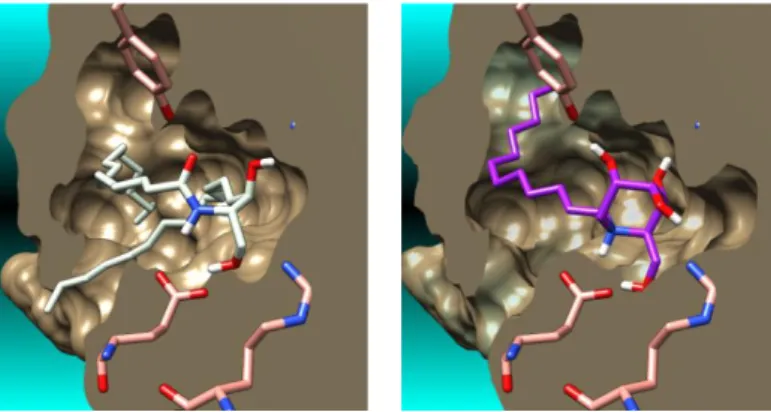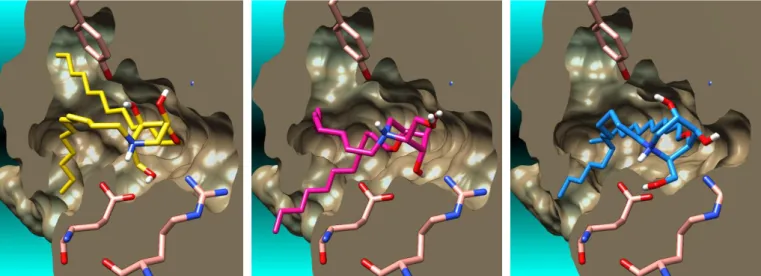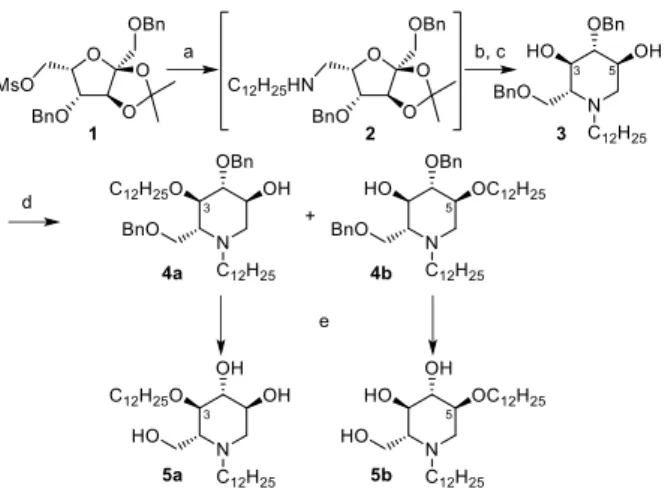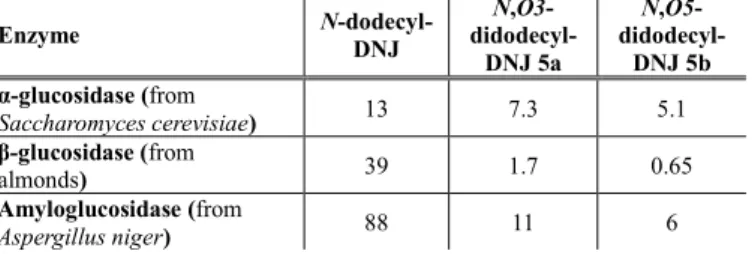HAL Id: hal-02362770
https://hal.archives-ouvertes.fr/hal-02362770
Submitted on 2 Dec 2020
HAL is a multi-disciplinary open access
archive for the deposit and dissemination of
sci-entific research documents, whether they are
pub-lished or not. The documents may come from
teaching and research institutions in France or
abroad, or from public or private research centers.
L’archive ouverte pluridisciplinaire HAL, est
destinée au dépôt et à la diffusion de documents
scientifiques de niveau recherche, publiés ou non,
émanant des établissements d’enseignement et de
recherche français ou étrangers, des laboratoires
publics ou privés.
N,O-Dialkyl deoxynojirimycin derivatives as CERT
START domain ligands
Tessa Castellan, Cecile Santos, Frédéric Rodriguez, Mathieu Lepage, Yan
Liang, Anne Bodlenner, Philippe Compain, Yves Génisson, Cécile
Baudoin-Dehoux, Stéphanie Ballereau
To cite this version:
Tessa Castellan, Cecile Santos, Frédéric Rodriguez, Mathieu Lepage, Yan Liang, et al.. N,O-Dialkyl
deoxynojirimycin derivatives as CERT START domain ligands. Bioorganic and Medicinal Chemistry
Letters, Elsevier, 2020, pp.126796. �10.1016/j.bmcl.2019.126796�. �hal-02362770�
N,O-Dialkyl deoxynojirimycin derivatives as CERT START domain ligands
Tessa Castellan,
aCécile Santos,
aFrédéric Rodriguez,
aMathieu L. Lepage,
bYan Liang,
bAnne Bodlenner,
bPhilippe Compain,
bYves Génisson,
aCécile Dehoux,
aStéphanie Ballereau.
a*a SPCMIB, UMR5068 CNRS-Université Paul Sabatier-Toulouse III, 118 route de Narbonne, Toulouse, F-31062, France. Email : ballereau@chimie.ups-tlse.fr b Laboratoire d'Innovation Moléculaire et Applications (LIMA, Univ. de Strasbourg | Univ. de Haute-Alsace | CNRS (UMR 7042), Equipe de Synthèse Organique et Molécules Bioactives (SYBIO), ECPM, 25 Rue Becquerel, 67000 Strasbourg, France.
Sphingolipids (SLs) are essential constituents of the cell membranes that also play a major role in signaling processes, notably in relation with cell growth, differentiation and apoptosis.1 The metabolism of SLs is finely regulated by a network of highly
compartmentalized, yet interdependent, enzymatic pathways centered on the pivotal metabolite ceramide (Cer). The complexity of this metabolism is also due to the specific subcellular localization of the corresponding enzymes, correlated to the marked hydrophobicity of most of the Cer derivatives.1 The conjunction of these two characteristics calls for specific transport mechanisms to transfer SLs between
organelles’ membranes. Thus, Cer generated on the cytosolic side of the endoplasmic reticulum (ER) has to be delivered to the trans-Golgi region to be further metabolized. In particular, Cer conversion into sphingomyelin (SM) relies on the selective trafficking operated by the ceramide transport protein CERT.2
Since the discovery in 2003 of this non-vesicular energy-dependent Cer transfer machinery,3 the study of CERT functions highlighted
its implication in various biological events. It is now established that CERT dysregulation is associated to several pathological contexts such as cancer. Several drug-resistant cancer cell lines, showing an increased CERT expression, could be re-sensitized to chemotherapeutic agents through CERT inhibition.4 Despite this metabolic significance, examples of CERT ligands are still limited.
Until very recently, the only family of intracellular Cer trafficking inhibitors was that of HPAs (N-(3-hydroxy-1-hydroxymethyl-3-phenylpropyl)alkanamides), first reported in 2001.5 This series was extended in 2015 to several C-alkylated analogs that proved to be up
to 3 orders of magnitude more affine to the protein than the reference compound HPA-12 (Fig. 1).6
Attempts to target CERT with entirely novel molecules remain on the other hand quite scarce. Thanks to virtual screening approach, an aromatic CERT inhibitor (HPCB-5, Fig. 1) was identified in 2019 by Kobayashi and Hanada and coll..7 Yet, the development of
original CERT ligand chemotypes is still relevant.
Fig. 1. Structure of known inhibitors of CERT: (1R, 3S)-HPA-12 and (1S, 2R)-HPCB-5.
In this search for new CERT ligands, we focused on the pharmacologically relevant iminosugar series. We thus recently designed N,O-didodecyl 1,5-dideoxy-1,5-imino-D-xylitol (DIX) derivatives as an original Cer mimic with significant binding to CERT (Fig. 2).8 In the
continuity of this work, we wish to report here the identification, in silico optimization, synthesis and protein binding study of alkylated deoxynojirimycin (DNJ) derivatives as new CERT-interacting molecules.
CERT is a 68 kDa cytosolic protein containing several motifs and domains: i) the N-terminal Pleckstrin homology (PH) domain ensures CERT association to the Golgi; ii) a serine-rich (SR) and a FFAT (diphenylalanine [FF] in an acidic tract) motifs located in the middle region are involved in the protein regulation and the interaction with the ER membrane, respectively; iii) the C-terminal steroidogenic acute regulatory protein-related lipid transfer (START) domain is directly responsible for the Cer transfer activity of the protein. The crystallographic structures of START domain either in its apo form or in complex with ceramides9 or (1R,3R)-HPA derivatives10 allowed
A B S T R A C T
Dysregulation of the ceramide transport protein CERT is associated to diseases such as cancer. In search for new CERT START domain ligands, N-dodecyl-deoxynojirimycin (N-dodecyl-DNJ) iminosugar was found to display, as a ceramide mimic, significant protein recognition. To reinforce the lipophilic interactions and strengthen this protein binding, a docking study was carried out in order to select the optimal position on which to introduce an additional O-alkyl chain on N-dodecyl-DNJ. Analysis of the calculated poses for three different regioisomers indicated an optimal calculated interaction pattern for N,O3-didodecyl-DNJ. The two most promising regioisomers were prepared by a divergent route and their binding to the CERT START domain was evaluated with fluorescence intensity (FLINT) binding assay. N,O3-didodecyl-DNJ was confirmed to be a new binder prototype with level of protein recognition in the FLINT assay comparable to the best known ligands from the alkylated HPA-12 series. This work opens promising perspectives for the development of new inhibitors of CERT-mediated ceramide trafficking.
the identification of the lipid binding site. In these co-structures, bound ligands are lying deep inside a large amphiphilic cavity closed by an amino-acid loop. Ligand polar head are involved in a network of H-bonds with hydrophilic amino-acids present at the bottom of the binding pocket, while their aliphatic chains follow preferential paths along the lipophilic walls of the cavity. Based on this background, we developed a combined in silico/in vitro approach11 to explore the binding of small molecules to the CERT START domain.
In the course of our precedent study on new iminosugar CERT START domain ligands that has led to the design of N,O5-didocecyl-DIX (Fig. 2) as an original binder,8 we also randomly evaluated other alkylated iminosugars, and unexpectedly, N-dodecyl DNJ gave
results that were worth to tackle and improve.
Fig. 2. Natural CERT cargo lipid C16-Ceramide (center), DIX-type iminosugar (left) and N-dodecyl-DNJ (right) protein binders.
N-Dodecyl-DNJ12 was prepared by alkylation of per-O-benzylated DNJ13 followed by debenzylation and was evaluated with the
previously developed fluorescence intensity (FLINT) binding assay.11 This binding experiment relies on the immobilization of a
histidine-tagged protein on a metal affinity resin. It uses a purposely-designed ceramide probe bearing a fluorescent tag at the terminal position of the sphingolipid skeleton. The extent of CERT START domain binding is correlated to the loss of fluorescence in the fraction of the ceramide probe bound to the protein, compared to the control value in the absence of competitor. To our surprise, N-dodecyl-DNJ gave 25% of residual fluorescence, thus revealing a level of protein recognition in the same range as the natural cargo lipid Cer, the benchmark antagonist HPA-12 or the designed ligand N,O5- didocecyl-DIX (Fig. 3).8
This finding contrasts with the fact that DNJ derivatives are not, a priori, good ceramide mimic candidates. Indeed, compared to Cer, the D-glucose-like DNJ iminosugar scaffold displays opposite configurations at the C-2 and C-3 centers bearing the primary alcohol and the adjacent secondary alcohol (Fig. 2). Prompted by the unexpected level of recognition of N-dodecyl-DNJ, its mode of binding to the CERT START domain cavity was scrutinized by means of the docking procedure previously developed with Molegro Virtual Docker software.11b The calculated complexes were compared with the C16-ceramide crystalline co-structures.9 In its bound state, Cer adopts a
typical "hairpin" conformation with the polar head displaying a strong hydrogen bond network with the surrounding protein amino acid residues (Fig. 4 left and 5 left). Notably, Glu446 develops a key interaction with the amide NH group while the amide carbonyl interacts with Tyr553. Cer primary hydroxyl group bounds to both Glu446 and Gln467 and the secondary alcohol displays an H-bond with Asn504. The lipidic chains typically stretch out along two orthogonal directions.
Fig. 3. Binding assays of a Cer fluorescent probe to START domain in the presence
of competitors (see ESI for experimental procedure). The bars represent the probe fluorescence as a percentage of the maximum value recorded in a control experiment without competitor. The protein/competitor/fluorescent probe ratio is 1:1:1 (final concentration 2.2 µM). Results are means from triplicate experiments.
Analysis of the minimized pose of lowest energy found for N-dodecyl-DNJ revealed a recognition pattern unexpectedly similar to that of Cer (Fig. 4 and 5). The iminosugar ring adopts an unusual all-axial chair conformation in which the protonated secondary amine nitrogen mimics the Cer amide NH group, giving a strong interaction with Glu446. As in Cer, the iminosugar primary alcohol also bonds both to Glu446 and Gln467. The adjacent secondary O-4 hydroxyl group gives an H-bond to Arg442. In addition, Tyr553, interacts with the O-5, located on the back side of the iminosugar scaffold. Importantly, the N-alkyl moiety nicely extends along the cavity in lieu of the Cer N-acyl chain.
Fig. 4. Molecular surface of the CERT START domain in complex with
C16-ceramide in its crystalline bound conformation (from PDB crystal structure 2E3P) (left) and calculated complexes of lowest energy between the CERT START domain and the N-dodecyl-DNJ (right)
Fig. 5. Binding modes of the crystalline C16-ceramide (from PDB crystal structure
2E3P) (left) and the docked pose of lowest energy of the N-dodecyl-DNJ (right) in the CERT START domain. The hydrogen bonds are depicted by dashed yellow lines and the distances between atoms are in Å.
Compared to Cer, the absence of a second alkyl chain in N-dodecyl-DNJ is likely to reduce the interactions with the hydrophobic regions of the cavity. We hypothesized that the introduction of an additional O-alkyl chain should reinforce the lipophilic interactions and strengthen the protein recognition, as we already observed in the DIX series.8 Moreover while N-alkylated-DNJs are known to inhibit
different glucose processing enzymes,14 the presence of a second O-alkyl chain is also expected to impair these activities,15 potentially
leading to a better compound selectivity profile.
Fig. 6. Schematic view of the N-dodecyl-DNJ Cer mimicking.
A second dodecyl chain, that would formally mimic the Cer alkyl chain (Fig. 6), could be readily introduced by etherification of one of the available hydroxyl groups of N-dodecyl-DNJ, i.e. on either O-3, O-4 or O-5 (Fig. 7). Each isomeric N,O-didodecyl-DNJs were thus docked to the CERT START to assess in silico the influence of an additional O-dodecyl chain on the protein-ligand interaction (Fig. 8 and 9).
Fig. 8. Molecular surface of the calculated complexes of lowest energy between the CERT START domain and the N,O4-didodecyl-DNJ (left),
N,O5-didodecyl-DNJ (middle) and N,O3-didodecyl-N,O5-didodecyl-DNJ (right).
Fig. 9. Binding modes of the docked pose of lowest energy of the N,O4-didodecyl-DNJ (left), N,O5-didodecyl-DNJ (middle) and N,O3-didodecyl-DNJ (right)
in CERT START domain. The hydrogen bonds are depicted by dashed yellow lines and the distances between atoms are in Å.
As expected in the case of N,O4-didodecyl-DNJ, since the O-4 points in the opposite direction of the N-alkyl chain (Fig. 6 and 8), the docked pose of lowest energy shows a complete frontward flip of the iminosugar ring in order to present the second alkyl chain in an appropriate direction. Expected interactions with Glu446 and Gln467 on the bottom face of the iminosugar ring, and with Asn504 and Tyr553 on the top face, are present. However, both dodecyl chains suffer a strongly unfavorable bent in order to allow proper alignment. In the docked pose of N,O5-didodecyl-DNJ, the positioning of the second alkyl chain on O-5 along the hydrophobic wall of the binding cavity induces a backward swiveling of the iminosugar scaffold. The secondary hydroxyl group in O-3 now bonds to Glu446, Gln467 and the primary alcohol interacts with Arg442 and Asn504. In consequence, the key interaction between the protonated secondary amine and Glu446 is lost in this orientation.
Finally, the calculated complex with N,O3-didodecyl-DNJ shows that introduction of the second dodecyl chain in O-3 induce only minimal perturbations of the iminosugar scaffold positioning in relation with N-dodecyl-DNJ. The two alkyl chains are nicely orientated along typical orthogonal lipophilic paths. Of note, a particularly dense H-bonds network is surrounding the polar iminosugar scaffold, involving all five available protein residues Arg442, Asn504, Glu446, Tyr553, Gln467. Despite their lack of structural similarity with the natural cargo lipid, comparison of the docked pose of DNJ derivatives with the Cer crystalline co-structure indicated that most of the expected interactions with the CERT START domain binding cavity could be retained. N,O3-Didodecyl-DNJ displayed an optimal calculated interaction pattern and was therefore expected to be the more affine ligand in this series. In order to confirm in vitro the binding to CERT START domain of the proposed dialkyl DNJ derivatives, we focused on the most promising and synthetically reachable compounds. N,O3-and N,O5-dodecyl-DNJ were thus prepared following a protocol described for shorter chains dialkyl-DNJ15 as
represented in scheme 1.
The mesylated 2,3-O-Isopropylidene-1,5-di-O-benzyl--L-sorbofuranose (1), obtained in six steps from commercially available 2,3:4,6-di-O-isopropylidene--L-sorbofuranose,16,15 was submitted to a nucleophilic substitution by dodecylamine to give the
corresponding aminosorbofuranose derivative 2, engaged without purification in the next steps: after acidolysis of the isopropylidene group, an intramolecular reductive amination of the resulting hemiketal furnished N-dodecyl-di-O-benzyl-DNJ 3.
Alkylation of the diol 3 with an excess of reactants led to a 40:60 mixture of the two regioisomers 4a and 4b. After chromatographic separation, each regioisomer was individually characterized thanks to a complete NMR assignment of 1H and 13C signals. Upon alkylation,
a downfield chemical shift (ca. 10 ppm) was typically observed for 3-C or 5-C, when compared to the starting compound 3, allowing unambiguous assignment of the structure 4a or 4b, respectively. The major compound is the 5-O-dodecyl derivative 4b, the OH-5 of 3 being slightly less hindered compared to OH-3. It is noteworthy that the formation of di-O-dodecyl compound was not observed as it was the case when shorter alkylating agents (butyl or octyl iodide) were used.15 Hydrogenolysis of the benzyl groups finally gave the expected
N,O-didodecyl-DNJ 5a and 5b.
Scheme 1. Reagents and conditions: a) neat dodecylamine, 85 °C, 16 h; b) TFA/H2O (9:1), 0-20 °C, 20 h; c) NaBH3CN, AcOH, MeOH, 72 h, 35% over 3
steps; d) NaH (6 equiv), dodecyl iodide (8 equiv), n-Bu4NI, (0.2 equiv), THF, , 36 h, 4a: 28%, 4b: 39%, recovered 3: 22%; e) H2, Pd/C, MeOH/CHCl3 (10:1), 48
h, 5a: 61%, 5b: 59%.
Having N,O3-didodecyl-DNJ 5a and N,O5-didodecyl-DNJ 5b in hands, we investigated their binding to the CERT START domain using the FLINT assay11 in comparison with the natural Cer and N-dodecyl-DNJ (Fig. 10).
To our satisfaction, when submitted to the FLINT assay, N,O3-didodecyl-DNJ 5a gave a residual fluorescence reduced to 20%, lower than for N-dodecyl-DNJ, Cer or 12. Of note, this value is close to the value observed in the same assay for long-chain C-alkyl HPA-12 analogues (unpublished results) previously identified as potent ligand by HTR-FRET assay.6 Introduction of a second alkyl chain on
O-3 of DNJ thus significantly strengthens protein recognition. On the other hand, N,O5-didodecyl-DNJ 5b presented a stronger residual fluorescence of 40%, indicating a level of protein binding even weaker than that of N-dodecyl-DNJ (25% residual fluorescence). This data suggests that the introduction of a second alkyl chain on O-5 of DNJ in 5b destabilizes the protein-ligand recognition.
Fig. 10. Binding assays of a Cer fluorescent probe to START domain in the presence of competitors (see ESI for experimental procedure). The bars represent
the probe fluorescence as a percentage of the maximum value recorded in a control experiment without competitor. The protein/competitor/fluorescent probe ratio is 1:1:1 (final concentration 2.2 µM). Results are means from triplicate experiments.
These results are in accordance with the qualitative analysis made by the molecular docking experiments and validate the in silico optimization of these new iminosugar START CERT ligands. When properly located at O-3, the second dodecyl chain thus likely contributes to add weak interactions along the lipophilic pathway of the START binding cavity without disrupting the H-bond network around the polar head.
We also postulated that the introduction of a supplementary O-alkyl chain on N-alkylated-DNJ derivatives will attenuate its glucosidase inhibitory effect and could lead to a potentially favorable selectivity profile. We thus evaluated the inhibitory activities of these compounds at 0.2 mM toward three representative glucosidases. As expected, an overall moderate level of activity was observed for the N-dodecyl-DNJ derivatives and the introduction of a second aliphatic chain further diminished this inhibitory potency (table 1).
Table 1: Inhibitory activities of N-dodecyl-DNJ, N,O3-didodecyl-DNJ 5a and N,O5-didodecyl-DNJ 5b towards glycosidases. Percentage of inhibition (%) at 0.2 mM Enzyme N-dodecyl-DNJ N,O3- didodecyl-DNJ 5a N,O5- didodecyl-DNJ 5b α-glucosidase (from Saccharomyces cerevisiae) 13 7.3 5.1 β-glucosidase (from almonds) 39 1.7 0.65 Amyloglucosidase (from Aspergillus niger) 88 11 6
In conclusion, in search for new CERT START domain ligands, we serendipitously found out that N-dodecyl-DNJ iminosugar displayed significant protein recognition. Stimulated by this finding, a docking study was carried out in order to select the optimal position on which to introduce a second alkyl chain. Analysis of the calculated poses for different regioisomers was confirmed by protein binding studies. N,O3-didodecyl-DNJ 5a was identified as a new binder prototype with level of protein recognition in a FLINT assay comparable to the best known ligands from the alkylated HPA-12 series. Despite of its a priori unfavorable D-glucose-like configuration, the DNJ
iminosugar core, when properly alkylated, appears to give rise to a dense network of protein interaction. This work opens new perspectives for further variation of the alkyl chains and development of new inhibitors of CERT-mediated ceramide trafficking.
References and notes
1. Hannun, Y. A.; Obeid, L. M. Nat. Rev. Mol. Cell Biol. 2017, 19, 175-191. 2. Yamaji, T.; Hanada, K. Traffic 2015, 16, 101-122.
3. Hanada, K.; Kumagai, K.; Yasuda, S.; Miura, Y.; Kawano, M.; Fukasawa, M.; Nishijima, M. Nature 2003, 426, 803-809.
4. (a) Lee, A. J. X.; Roylance, R.; Sander, J.; Gorman, P.; Endesfelder, D.; Kschischo, M.; Jones, N. P.; East, P.; Nicke, B.; Spassieva, S.; Obeid, L. M.; Birkbak, N. J.; Szallasi, Z.; McKnight, N. C.; Rowan, A. J.; Speirs, V.; Hanby, A. M.; Downward, J.; Tooze, S. A.; Swanton, C. J. Pathol. 2012, 226, 482-494; (b) Swanton, C.; Marani, M.; Pardo, O.; Warne, P. H.; Kelly, G.; Sahai, E.; Elustondo, F.; Chang, J.; Temple, J.; Ahmed, A. a.; Brenton, J. D.; Downward, J.; Nicke, B. Cancer cell 2007, 11, 498-512.
5. Yasuda, S.; Kitagawa, H.; Ueno, M.; Ishitani, H.; Fukasawa, M.; Nishijima, M.; Kobayashi, S.; Hanada, K. J. Biol. Chem. 2001, 276, 43994-44002.
6. Ďuriš, A.; Daïch, A.; Santos, C.; Fleury, L.; Ausseil, F.; Rodriguez, F.; Ballereau, S.; Génisson, Y.; Berkeš, D. Chem. – Eur. J. 2016,
22, 6676-6686.
7. Nakao, N.; Ueno, M.; Sakai, S.; Egawa, D.; Hanzawa, H.; Kawasaki, S.; Kumagai, K.; Suzuki, M.; Kobayashi, S.; Hanada, K. Commun.
Chem. 2019, 2, 20.
8. Santos, C.; Stauffert, F.; Ballereau, S.; Dehoux, C.; Rodriguez, F.; Bodlenner, A.; Compain, P.; Génisson, Y. Bioorg. Med. Chem. 2017,
25, 1984-1989.
9. Kudo, N.; Kumagai, K.; Tomishige, N.; Yamaji, T.; Wakatsuki, S.; Nishijima, M.; Hanada, K.; Kato, R. Proc. Natl. Acad. Sci. U. S. A.
2008, 105, 488-493.
10. Kudo, N.; Kumagai, K.; Matsubara, R.; Kobayashi, S.; Hanada, K.; Wakatsuki, S.; Kato, R. J. Mol. Biol. 2010, 396, 245-251. 11. (a) Combemale, S.; Santos, C.; Rodriguez, F.; Garcia, V.; Galaup, C.; Frongia, C.; Lobjois, V.; Levade, T.; Baudoin-Dehoux, C.;
Ballereau, S.; Genisson, Y. Rsc Advances 2013, 3, 18970-18984; (b) Santos, C.; Rodriguez, F.; Garcia, V.; Moravcikova, D.; Berkes, D.; Daich, A.; Levade, T.; Baudoin-Dehoux, C.; Ballereau, S.; Génisson, Y. ChemBioChem 2014, 15, 2522-2528.
12. Baxter, E. W.; Reitz, A. B. J. Org. Chem. 1994, 59, 3175-3185.
13. Compain, P.; Decroocq, C.; Iehl, J.; Holler, M.; Hazelard, D.; Mena Barragán, T.; Ortiz Mellet, C.; Nierengarten, J.-F. Angew. Chem.
Int. Ed. 2010, 49, 5753-5756.
14. (a) Mellor, H. R.; Nolan, J.; Pickering, L.; Wormald, M. R.; Platt, F. M.; Dwek, R. A.; Fleet, G. W. J.; Butters, T. D. Biochem. J. 2002,
366, 225-233; (b) Butters, T. D.; van den Broek, L. A. G. M.; Fleet, G. W. J.; Krulle, T. M.; Wormald, M. R.; Dwek, R. A.; Platt, F.
M. Tetrahedron: Asymmetry 2000, 11, 113-124.
15. Boucheron, C.; Desvergnes, V.; Compain, P.; Martin, O. R.; Lavi, A.; Mackeen, M.; Wormald, M.; Dwek, R.; Butters, T. D.
Tetrahedron: Asymmetry 2005, 16, 1747-1756.




